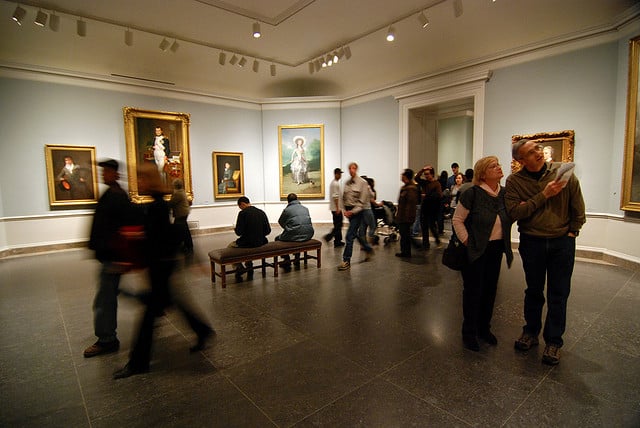
Photo: Kevin Harber (CC BY-NC-ND 2.0)
Being watched
Dirk vom Lehn explains how video-based research into social interactions in museum or gallery exhibitions can be used to develop new resources and inform arts marketing.
Over the past two decades museum visitor research has become increasingly interested in how visitors experience and make sense of exhibits in interaction and discussion with friends, family and other people. By using video recordings as principal data, we can explore how people examine and experience features of paintings, sculptures and other artefacts on display while interacting with others.
In the past, visitor research would ascribe ‘attracting power’ and ‘holding power’ to exhibits, i.e. the power to draw people in and hold their attention for considerable time. Now, we are interested in how people explore exhibits and exhibitions in interaction with companions and other people who are there at the same time. For example, at a funny mirror a visitor will not describe the reflection in the mirror to a companion, but they will do or say something that encourages a companion to discover the reflection for themselves and display surprise, maybe by laughing out loud. Or at a Caravaggio painting a visitor will progressively make the artist’s incisions in the canvas visible to companions by encouraging them to also crouch and look at the piece from the bottom upward.
This kind of research at the exhibit-face can inform the design and deployment of novel hi- and low-tech resources
The companions’ laughing in front of the mirror or the “oohs and mhms” at the Caravaggio are not displays of an inner, subjective state produced in response to exhibit features, but they are actions through which visitors attend to or align with companions’ actions at the exhibit-face. Moreover, the laughing and the particular positions and postures at an exhibit might be noticed by other visitors in the gallery, who might use their observations as information on where to stand and how to look at an exhibit to be able to discover something interesting about it.
The analysis suggests that people’s experience of exhibits and exhibitions is principally produced in social interaction. Visitors are ‘ad-hoc experience producers’ who use the offerings of a museums as information in their interaction with others. This information may be used to influence and enhance each other’s museum visit and experience. Curators and designers therefore do not prefigure what visitors look at and how they see it, but they provide visitors with resources they might draw on when exploring exhibits in interaction with others. It would seem that they might benefit from cooperation with visitor researchers who examine the action and interaction at the exhibit-face. Detailed information on how people interact with each other in exhibitions and how they use resources provided by museums, including exhibits, labels or more recently stationary and mobile digital systems, can inform the design and deployment of new exhibitions and information resources that enhance visitors’ social experience of museums.
Save for their relevance for curators and designers, the observations also have implications for arts marketing. Hye-Kyung Lee recently highlighted on this website that arts marketing needs to take seriously the active consumer who produces content while engaging with culture and media content. The research reveals that in museums people continually create their own interpretation of exhibits when talking and interacting with others. If arts marketing wants to take the active museum visitor seriously it has to move on to the exhibition floor and study the emergence of visitors’ interpretation of exhibits at the point of experience, i.e. at the exhibit-face. Equipped with findings from such research, arts marketing can inform curators, managers and designers in developing and deploying innovative exhibitions for active visitors.
Dirk vom Lehn is based in the Department of Culture, Media & Creative Industries at King's College London.
www.kcl.ac.uk/cultural
E: [email protected]
Tw: @dirkvl
Comment from Deborah Bull
For museum curators, managers and designers, notions of how the visitor acts – and reacts – at what Dirk calls the ‘exhibit-face’ are of fundamental importance. The vision of an active rather than a passive visitor has serious ramifications for how exhibitions are created and provide real opportunities for innovation, particularly as new technology comes increasingly into play. How do we shape exhibitions in such a way that leaves room for visitors to be part of the creation process? What role is there for the visitor as curator? And how can we enhance the interactions that occur naturally at the exhibit-face?
This article and the short summary on the CultureCase website are designed to provide an entry point into Dirk’s research for arts and cultural professionals. CultureCase aims to make academic research accessible to those people who can benefit from it the most.
Deborah Bull is Director, Cultural Partnerships, King’s College London.
www.kcl.ac.uk/cultural
This article is a summary of research prepared for CultureCase, a new resource from King’s College London to allow the sector to access academic standard research. A copy of the full academic article is available.
Join the Discussion
You must be logged in to post a comment.